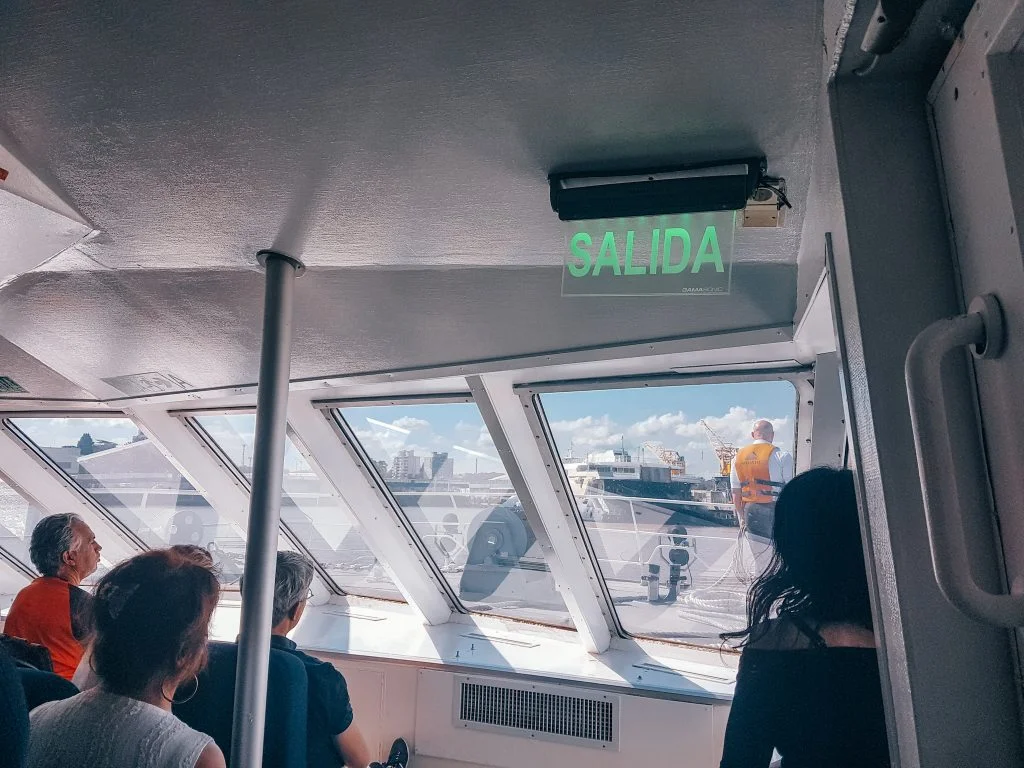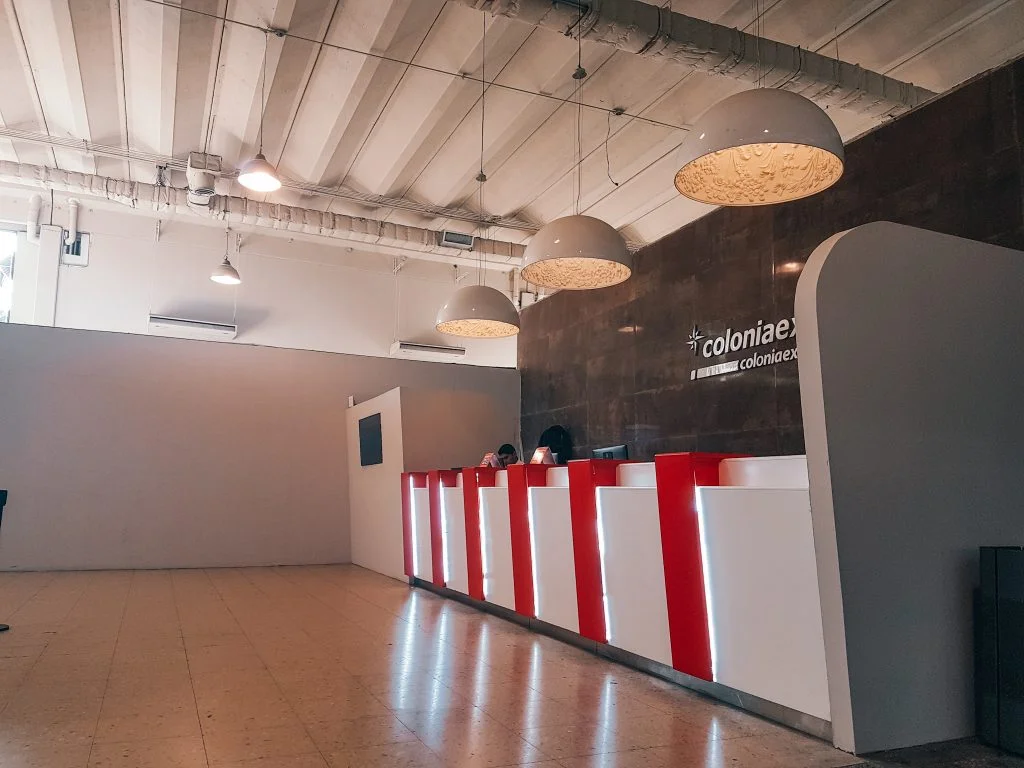Not too many travelers put Uruguay on their list of places to visit when thinking of visiting South America. But if you find yourself in Buenos Aires, the ease of taking the ferry to Uruguay makes this a great way to see some of the many wonderful things the country has to offer. Because taking the ferry from Buenos Aires is so easy, this activity is great even if you have just a day to visit one of Uruguay’s coastal cities. Here, we’ll outline all you need to know about hopping from Argentina to Uruguay.

Booking Your Ferry
Though there were plenty of tours, buses, etc. that we booked last minute in South America, the ferry from Buenos Aires to Uruguay is something we recommend booking at least a few days in advance. This will ensure that you have time to organize transport to the port, your documents for crossing the border, any tours you want to have in place, etc. It will also secure your spot on the ferry as trips to Uruguay’s Colonia Del Sacramento are also quite popular with locals, especially on holidays and weekends.

Companies
There are two main companies that run ferries between Buenos Aires and Colonia, Montevideo, and a couple other cities. They are Colonia Express and Buquebus. The main factors to consider when booking are schedule, what city you’re heading to, and price. Overall, the two companies are pretty similar.
The cheapest option is to take the ferry from Buenos Aires to Colonia and get off there. Even if you want to go to Montevideo, it is generally cheaper to go by bus from Colonia than to take the ferry directly to Montevideo from Buenos Aires. Buquebus and Colonia Express both offer the bus segment in their trip packages. We booked through Colonia Express, taking the ferry to Colonia and then a bus straight to Montevideo.

Timing
Buquebus has two different boat types, and we recommend taking the smaller and faster option. It takes between 1h to 1h15m to reach Colonia. If you take the ferry direct to Montevideo, it will take between 2h15m and 3h. If you want to visit Montevideo and are in a time crunch, the direct ferry may be a better option because the overall duration of travel will be shorter than if you get off the boat in Colonia and wait for everybody to board the bus to Montevideo. Buquebus generally offers direct ferries to Montevideo more frequently than Colonia Express.
Both companies have ferries leaving Buenos Aires multiple times a day. The time you choose obviously depends on your own schedule, but we recommend taking the earliest, especially if you are going for a day trip. This will give you time to enjoy Uruguay for the day and ensure that you reach your destination city and accommodation at a good hour if you are staying in Uruguay overnight.

We went with Colonia Express and took the earliest boat available on that day. We opted for a one way ticket that included the ferry ride to Colonia and bus to Montevideo. It was a little cheaper on the way back.
Prices may vary depending on the day of the week, time of day and year, and which city you select to travel to. Booking online gave us a discount. Prices also fluctuate quite a bit due to the drastic change in value of the Argentine peso. Always check the direct company websites (linked in previous section) for schedule and price changes.
Border Requirements
Before we dive into the requirements for entry to both Argentina and Uruguay, please note that the requirements may vary depending on your citizenship and regulations may change at any time. It is always important to check your government resources before travelling.

Uruguay
For citizens of many territories, including the United States, Australia, Canada, members of the EU, Mexico, Bolivia, Argentina, and more, only a valid passport or ID card are needed to enter Uruguay if your visit is under 90 days and your purpose is tourism. Make sure that you have a blank page in your passport for entry and exit stamps.
If you are a national of a country that needs a visa to enter Uruguay, you may need to pay a fee, fill out a visa application form, and submit copies of your passport and other documents. Click here to see if you may need a visa and check your government website for official details and travel requirements. We don’t think that Colonia Express or Buquebus provide visa services, so this needs to be done in advance.
According to some websites/officials, a yellow fever card may be required if you are coming from a high-risk area within 5 days. We received the vaccination before our year in South America, but coming from Buenos Aires, we were not required to present the card.

Argentina
We felt very lucky because, not long before our time in Argentina, the government got rid of the $160 required reciprocity fee per US citizen to enter. Nationals of the United States, Australia, members of the EU, Canada, Brazil, Bolivia, and more can enter visa-free with a valid passport or ID card. Like in Uruguay, this applies only to touristic stays of 90 days or less. You may need to present additional documentation for business or other travel purposes.
As when travelling to Uruguay, you may need to pay a fee, fill out a visa application form, and submit copies of your passport and other documents if you are a national of a country requiring a visa to enter Argentina. Click here to see if you require a visa to visit Argentina and check local governing agencies for current travel requirements.
Taking the Ferry from Buenos Aires
Before leaving for the port, we made sure we had our printed tickets and passports accessible. We took a taxi to the Colonia Express terminal first thing to catch the boat. The officials recommended we arrive 1.5 to 2 hours before our departure. Because we were staying in Uruguay for a couple weeks and had all of our belongings to bring through customs, we made sure to get there at the recommended time.

Turns out, the time was more than adequate, but the boat was also only about half full. We waited in the upstairs terminal until it was time to board. Seating on the boat is also not assigned, which is another reason you should arrive on time. If you get motion sickness easily, try finding a window seat or a seat up front.
You can stow smaller bags near your seat. If you have larger luggage, staff will take your bags and store them for the ride. You will need to wait to grab them upon leaving the boat. We settled into our seats. There are some snacks and even liquor for sale on the boat.
After the slow ride, we docked in Colonia Del Sacramento. Our first destination was Montevideo, so we caught the immediate connecting bus already organized in the Colonia Express trip package. If you desire to explore Colonia a bit before heading elsewhere, you can always book a separate bus at a later time.

Day Trip Considerations
We truly enjoyed spending a couple weeks in Uruguay, but many choose to make a day trip from Buenos Aires. While both main ferry companies offer direct trips to Montevideo, Colonia, and some other spots, we recommend going to Colonia if you only have a day.
Colonia is closer, ensuring that you have more time to spend exploring there. This town is smaller and more peaceful than Montevideo, but there are still plenty of small shops, tasty restaurants, quaint streets, quiet beaches, and more for a laid back day in Uruguay.

As a bigger city, Montevideo offers more of a bustling scene. It’s a little more important to plan ahead if you want to visit here because the city is more sprawling and there are more museums and other options for things to do. If you do choose to visit Montevideo for just a day, you will be spending more of your day travelling than if you visit Colonia.
Colonia is the better option for a day trip in our opinion. However, you really can’t go wrong visiting either of these beautiful cities!
Like this Post? Pin it!





Great advice. Very much appreciated!